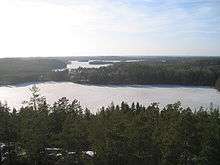Vehkalahti
Vehkalahti (Swedish: Veckelax) is a former municipality surrounding the town of Hamina in south-eastern Finland. At the beginning of 2003 Hamina and Vehkalahti combined to form a new town of Hamina.

History
These southern parts of Karelia is known to be the oldest parts of modern Finland with settlements. First markings of Vehkalahti as a continuous settlement or village are dated in 1336, when it has become a major place for east/west trading. The plans to build a town grew slowly as the place become crowded. In 1653 the area surrounding the village church officially became a town, which was called Vehkalahden Uusikaupunki (Swedish: Veckelax Nystad, English: Newtown of Vehkalahti).[1][2]
Surroundings
While the area in the immediate vicinity of the church building became a town, the surrounding land remained countryside. Formerly the area of Vehkalahti was much larger, almost the entire Kymenlaakso, but later many areas became new municipalities.[3] Largest population centers are Husula, Salmenkylä, Uusi-Summa, Poitsila and Neuvoton, there are also many rural villages like Metsäkylä, Reitkalli, Kannusjärvi and Pyhältö.
Peculiar Nobility
In literature, Vehkalahti is particularly renowned for its peculiar medieval petty nobility, knaappiaateli (families Husgafvel, Pilhjerta and Brandstaka), which also acted as a link between Vehkalahti and the Vyborg Castle. Built by Swedes, about 100 kilometres (60 mi) east of Vehkalahti, it became place of great military importance for European east/west foreign communication. Today it is located on Russian territory.
Vehkalahti church
The Vehkalahti church (now known as St. Mary's church, or Marian kirkko in Finnish) was built in the 14th century at the place where the town of Hamina is now.
References
- Sjöström (2011), "Medieval landed inheritances of the Junkar and Vilken lineages of Vehkalahti, Finland", Foundations: Journal of the Foundation for Medieval Genealogy, vol 3 issue 5 (2011 January), pp 425–461
- Sjöström (2011), "Y-DNA and records of medieval land inheritance in Rolandh and Tepponen lineages of Vehkalahti, Finland", Foundations: Journal of the Foundation for Medieval Genealogy, volume 3 issue 6 (2011 July) pages 527..563
| Wikimedia Commons has media related to Vehkalahti. |
